Make a Wish!
Audrey Schmidt
Lewis Fidock and Joshua Petherick’s works have a theatrical quality, steeped in the pathos of fantasy, haunted by apparitions, spectres and illusory likenesses. Philip Brophy’s review of the pair’s 2020 show Weevils in the Flour likened the atmos to DnD, Labyrinth (1986), The Dark Crystal (1982), Myer Christmas window displays, and “olde worlde” themed restaurants. It’s easy to get consumed by cinematic similes, ending up with more meaningful information than you can possibly synthesise. It may be a classic writerly faux pas that Brophy and I are particularly susceptible to, but it’s galvanised by Fidock and Petherick’s strategy of dissolving nostalgia, speculative futures, and parallel timelines in an uncanny dimension of presentness. Make A Wish! at Asbestos is no exception to their emotionally cunning world-building tradition.
The Asbestos shed is home to six immaculately produced oversized leaves—a mix of downtrodden neighbourhood varieties. Their scale makes the space diorama-like—the “Escher room” effect you’d expect to find in a science museum. Each leaf is in a distinct stage of decomposition, strewn across the space with autumnal nonchalance.
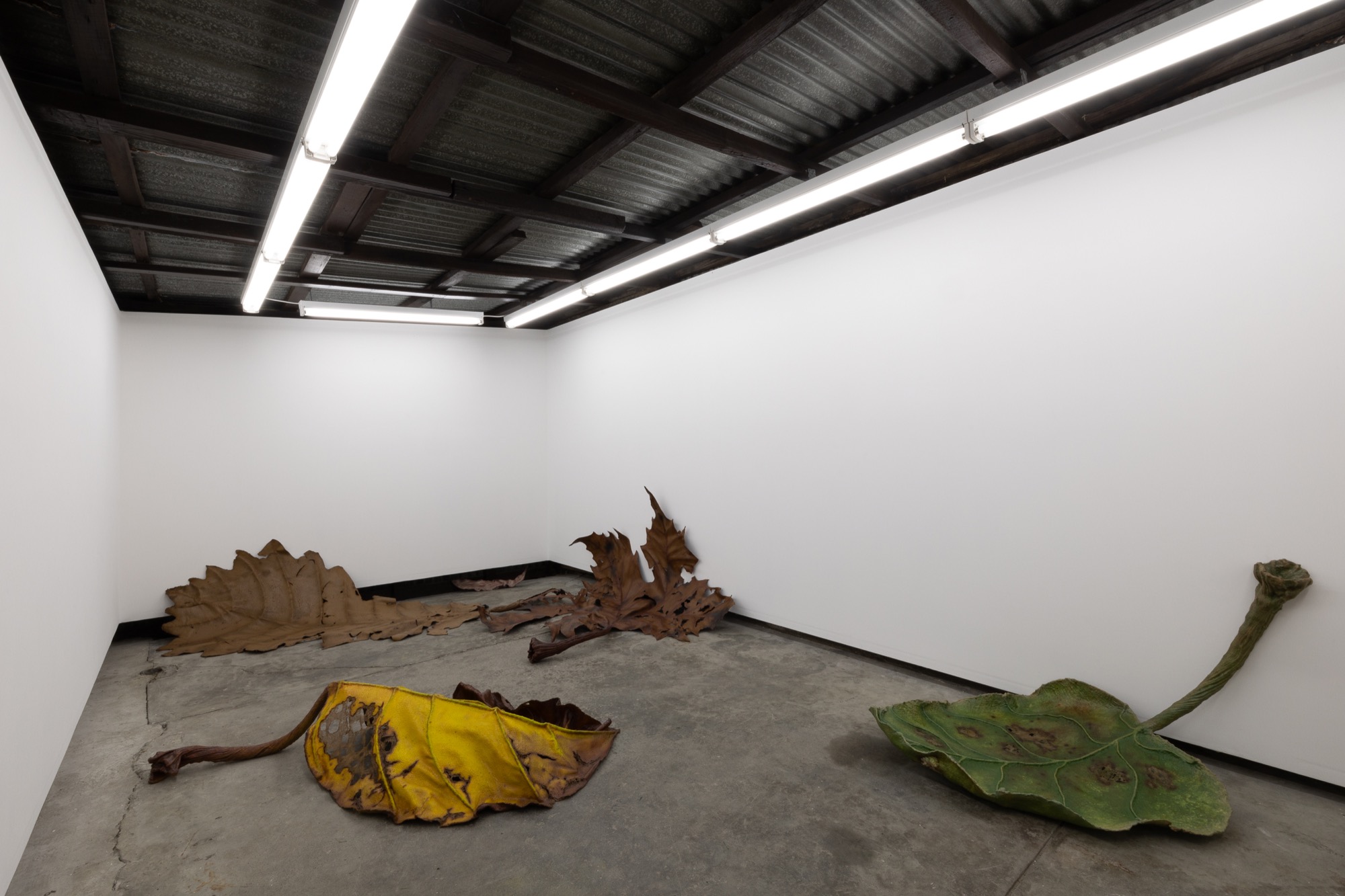
Perhaps it was the science museum effect from the outset, but the first dreaded cinematic simile to cross my mind is The Land Before Time (1988). A Spielberg/Lucas production, directed by Don Bluth, this is another film emerging from the Labyrinth and The Dark Crystal pipeline. It came out the year Fidock was born, the year before I was born, and if you’re around our age, this film causes you to fondly clasp your hands to your heart, pathetically overcome by the trenchant impossibility of returning to the past.
Beyond millennial nostalgia, that’s what the film is actually about. It follows the journey of five young dinosaurs searching for the “Great Valley,” a plentiful oasis carved out for the last remaining herbivores on earth, free from the famine, drought, geological upheaval, and starving predators that threaten their survival. It represents the irreparable past of environmental sustainability, but also a paradise or afterlife. These child-dinos are the last of their species, so although it is introduced as “a journey toward life” with hope for a better future, it is in fact a journey toward death; one that is designed as a kind of grief education for children who are the inheritors of The End. It has to be my favourite genre.
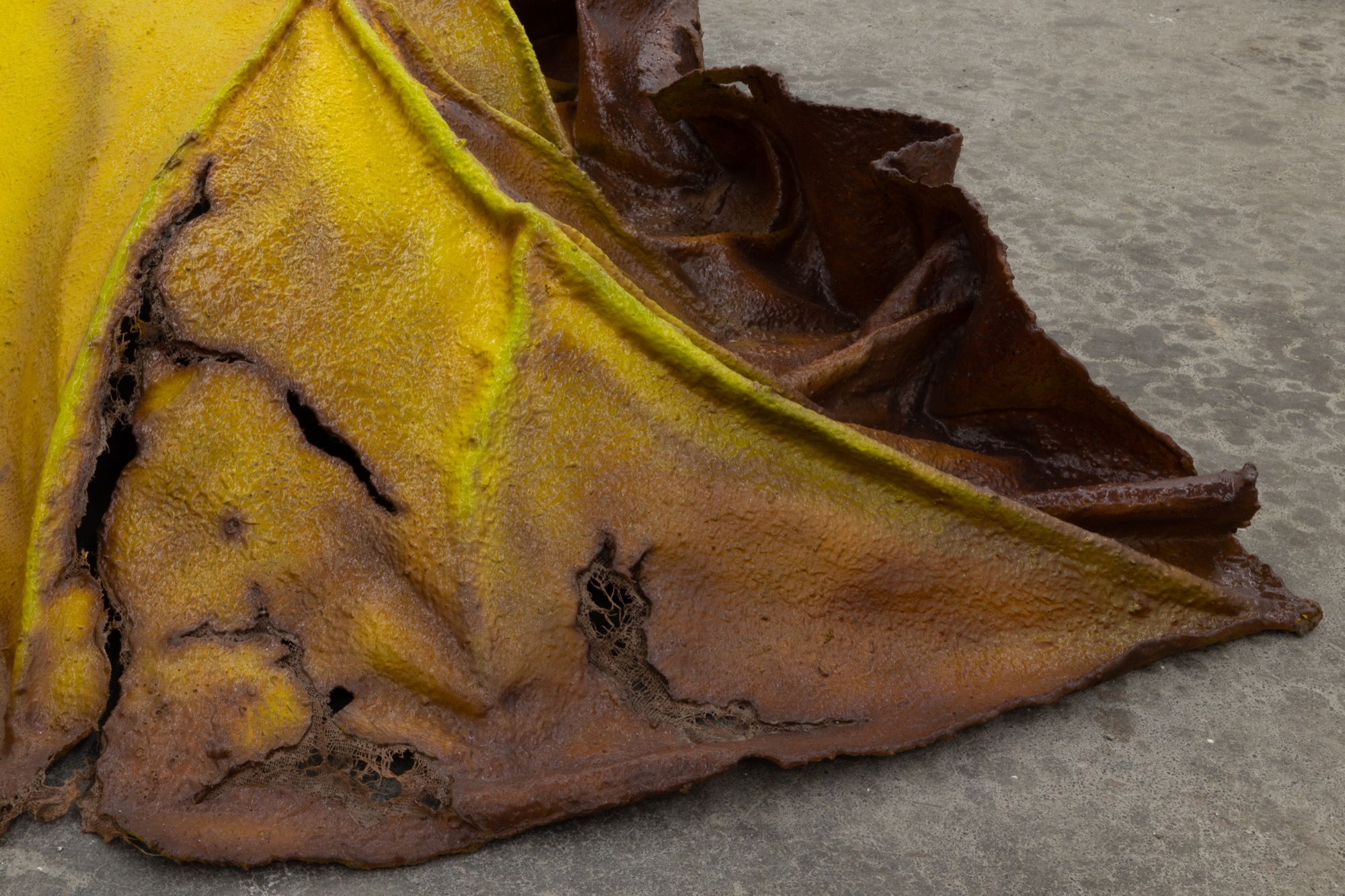
Petherick and Fidock have an almost paleontological approach to their work. Through strategic sampling, the past is re-staged by pushing genuine historicity against its perpetual revision and narrativisation, weakening the structure at each recast. Last I checked, we weren’t sure if dinosaurs had feathers or scales, but I can’t say that I’m keeping abreast of the research. Of course, that is why they’re such ideal storytelling vehicles. Make A Wish!, like all of the artists’ collaborative work, is infused with a whimsical and elusive literary quality. The autumnal pathetic fallacy rests on its duality as a symbol of plenty (harvest) and of decay. Past the prime of summer and into the “dead” of winter. The painted latex structures of the leaves more advanced in their simulated decomposition are worn away in parts to reveal a membrane of muslin and burlap, imitating organic veins. Scale aside, they are not perfect replicas by any account. There is a postmodern pleasure in the fakery that some of the rare and collectible publications at World Food Books (run by Petherick) might be able to illuminate. I am thinking particularly of the time I spent money I didn’t have on some vhtf rags about pre-cgi, straight-to-video horror prosthetics and SFX, dripping with liquid latex how-tos. But the most fruitful medium through which to discuss the vitality of objects is animation.
The most important symbol in The Land Before Time is the Tree Star. It is a single leaf discovered on an otherwise barren tree that is gifted to the main character, Littlefoot, by his mother who gets tragically attacked by a T. rex before falling to her death between colliding tectonic plates at the very outset of the film. The leaf is at once a token of hope for the bountiful future to come in the Great Valley and a means to access the memory of his mother. The Tree Star is to Littlefoot as a madeleine is to Proust: a portal into the past opened up by the senses without apparent will or consciousness. There are some continuity issues (it underwent severe late-production edits to make it less intense for kids), but Littlefoot carries the Tree Star on his back or carefully rolled up in his mouth for most of the film. Despite its material worth as a food source (particularly for a “Leaf Eater”), he never acknowledges it as such. It functions purely as a symbolic link to the timelessness of the afterlife and its dewey green surface never decomposes. Linear histories are complicated, and when the dinosaurs reach the Great Valley at the end of the film, it’s unclear if they’ve made it to the land of plenty or if the crew have died and gone to heaven.
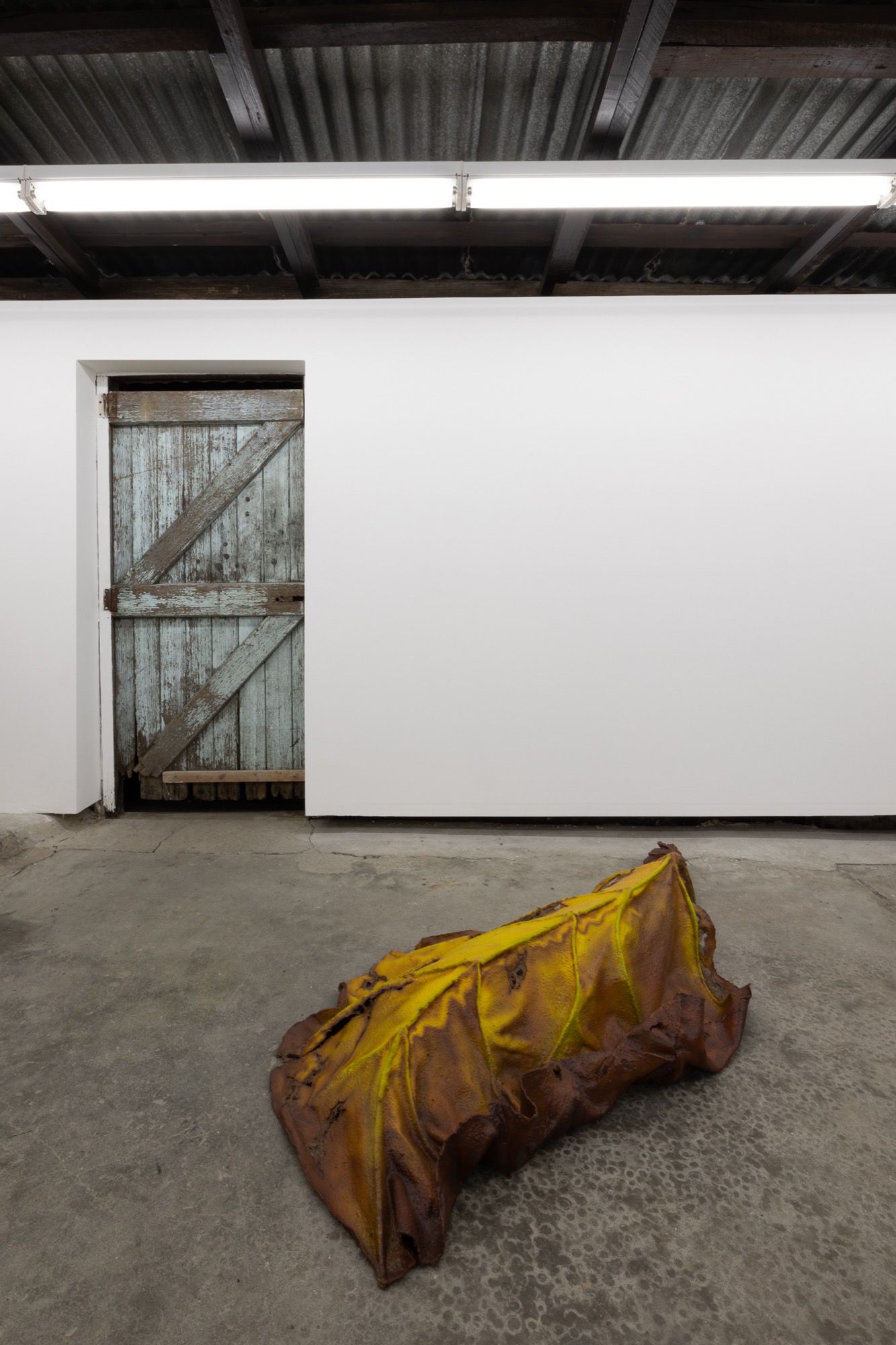
The interstice between fantasy and reality as an intervening space as well as an interval of time is a recurrent theme for Petherick and Fidock. Weevils n The Flour included lamps (the Weevils) that lined the walls and “burned” in short, animated jumps and flickers, powered by electronics. While realistic LED flame lamps are able to emulate fire with near indistinguishable similitude, these ones were self-consciously fake. Although lacking the more fluid movements of real fire or more contemporary fake-fire equivalents, they embodied an offbeat life of their own with stilted mechanical bursts of movement. To throw in another illusory likeness, the Weevils recalled the iconic lamppost of Narnia’s Lantern Waste, a living organism with an undying fire that burns without fuel. Born as an iron bar thrown at Aslan by the White Witch, it transforms into a lamppost after hitting the preternaturally fecund soil of Narnia under the spell of Aslan’s song. This cyborgian lamppost that springs from the earth becomes a landmark that defines the boundary between the real world/wardrobe and the fantasyland of Narnia.
One of the Weevils lamps remains on display at World Food Books and each time I see it, it pricks my senses. Petherick and Fidock harness child-like wonder in a way that is so deftly manipulative feels Disney. They unnervingly work in the same enchanting way without ever having to be so crude. Each exhibition feels as though it’s a part of the same mysterious universe (or at least the same magical props department as Brophy would have it) that is quietly foreboding in its out-of-timeness. It’s a universe that is as ontologically unfinished and fragmentary as reality itself—because it is real.
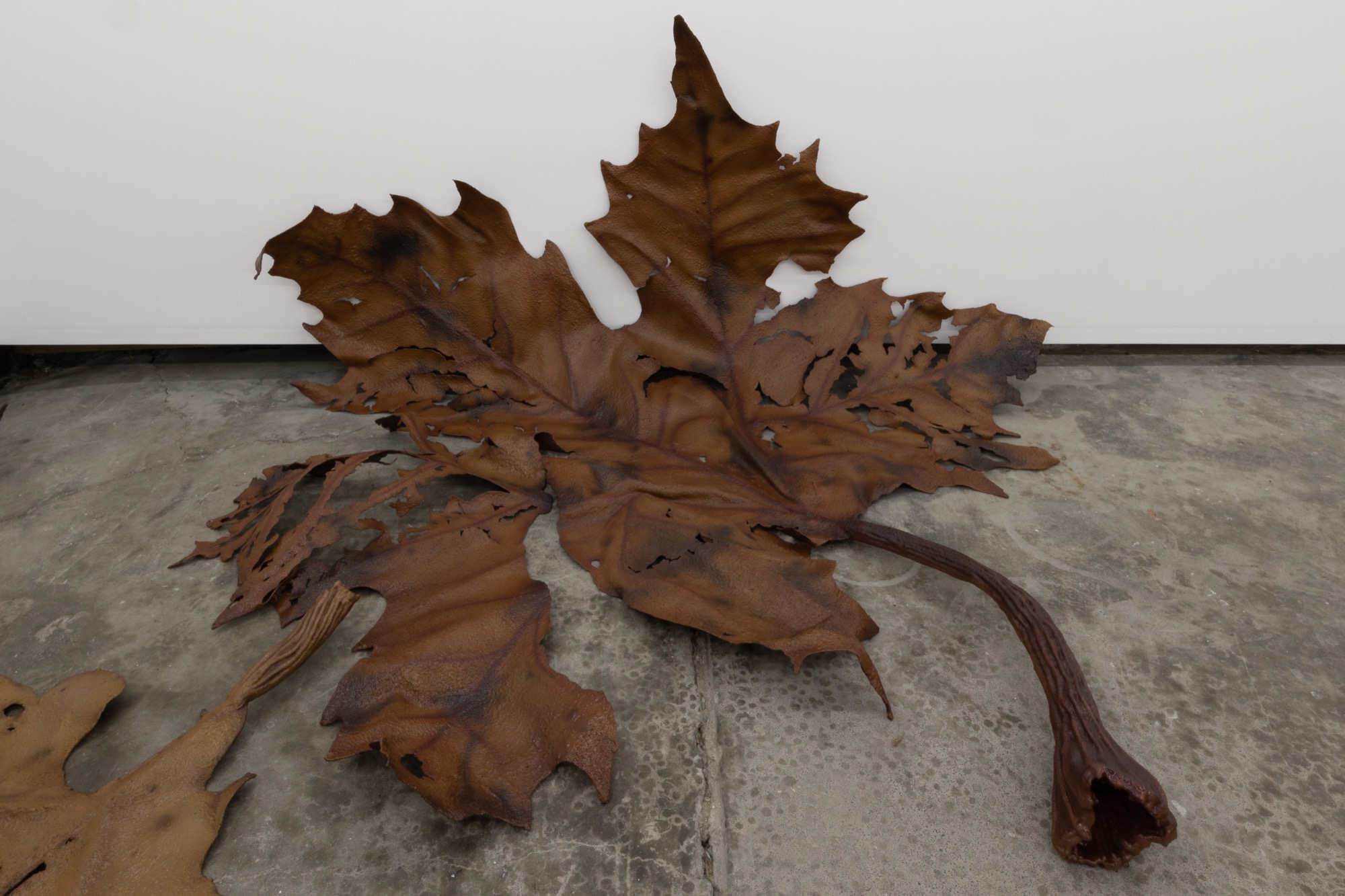
Both Fidock and Petherick are refined (and very niche) collectors and producers of cultural artefacts, which could explain their in-tuneness with the preservation drive that informs their archaeologically adjacent approach. World Food Books hosts a unique selection of rare or out-of-print books, journals, and editions, which I know would be put to shame by Petherick’s personal collection. And you might flip over a record at a nice inner-city shoppe to find their names next to the cover art on an obscure re-release by Efficient Space or a Left Ear compilation, two independent labels that are likewise obsessed with the excavation, digital restoration and preservation of underground and forgotten Australian music. The more humanity’s survival is in question, the “more meticulously we preserve its remains” Baudrillard writes. His metaphor? “The traces of the dinosaurs howl in our memories. Had they been alive, we would have exterminated them, but we respect their traces.”

Now that Melbourne’s foremost share-house gallery institutions, Guzzler and Meow2, have closed their doors, something else is howling to be remembered in what’s left behind. Although neither Petherick or Fidock showed at Meow or Guzzler, you can find traces of them on Melbourne Offsite Index—a 2015 to 2016 time capsule of parainstitutional scene collaboration that split on their journey to the Great Valley. It was a clear influence on what was to become Suicidal Oil Piglet, Meow, and, with an injection of private funding and influence, Centre D’Editions. But the most enduring fossil is Punk Café and Liam Osborne. It was at Punk Café that you see precursors to the Vivian/McCrackpipe Disposal Platters that became a Guzzler staple. One of the earliest Petherick-Fidock collaboration shows, A Cut From Occam’s Razor (2016), was there. And Liam himself is everywhere. The “missiles” from Peace Frog (2021) that remained in the Meow2 courtyard after his death felt like an important Tree Star madeleine. One that is soon to be displaced, even if we hold out hope for Meow3. A friend of Liam’s (Corrie) wrote on Instagram that watching him pick up the tools from Guzzler after Luke finished building the walls before heading to Meow2 to lay out the plywood floors is one of her fondest memories. He’s in the very infrastructure of a scene that threatens us with extinction.
The title of Hana Earles’s first show at Meow in 2019 was The Wish Academy, which sounds like an art school for cancer patients, but the imperative exclamation makes all the cheerful difference. The exhibition poster for Make A Wish! features a dandelion’s seed head that serves, like the Tree Star, as a symbol of hope and the circle of life. When you blow to make a wish, the seeds disperse and can travel up to 100 kilometres before germinating, the farthest of any plant in the world. It is this kind of unpretentious magic that permeates Make A Wish!. Which is why, even for all the maudlinness of nostalgia, it is hopeful—in an unexpectedly mundane way. Meow2’s final exhibition text for Being Different (2023) captured something of this sentiment: “If it started like a party then it will end like a funeral, or maybe just like breakfast, croissants and coffee, we all have nicer apartments now.” It suddenly feels like prophecy that Liam’s centrepiece for Peace Frog, a large rotating peace symbol, was named For everything there is a season.

The compounded loss may incite us to catastrophise all of this as utter dissolution: a scene in ruins. But it would be too easy (and discordant with Wake A Wish!) to reinforce the imagined authenticity of the communities of the past at the expense of appreciating the present and welcoming the future. I mean, isn’t this the failure of Melbourne Now? In a lazy attempt to historicise the present, they’ve unwittingly produced a 2013 retrospective for the heydayers. Asbestos is a different organism anyway, at a remove from the aesthetics of “Meowcore” (the title of a recent unofficially affiliated student show at VCA Art Space and testament to the enduring legacy of the polyonymous monster with tattered ribbons in its hair that I wish I’d never named). Asbestos is cleaner cut, glossy but not garish. Just look at their fabulous new ad in Texte zur Kunst. It’s a beacon of youthful promise and optimism trapped in a real-world Windows XP desktop utopia. To rip and rework the classic 2000s Diesel campaign that the gallery’s ad is akin to: “Innocence is now sponsored by Asbestos.”
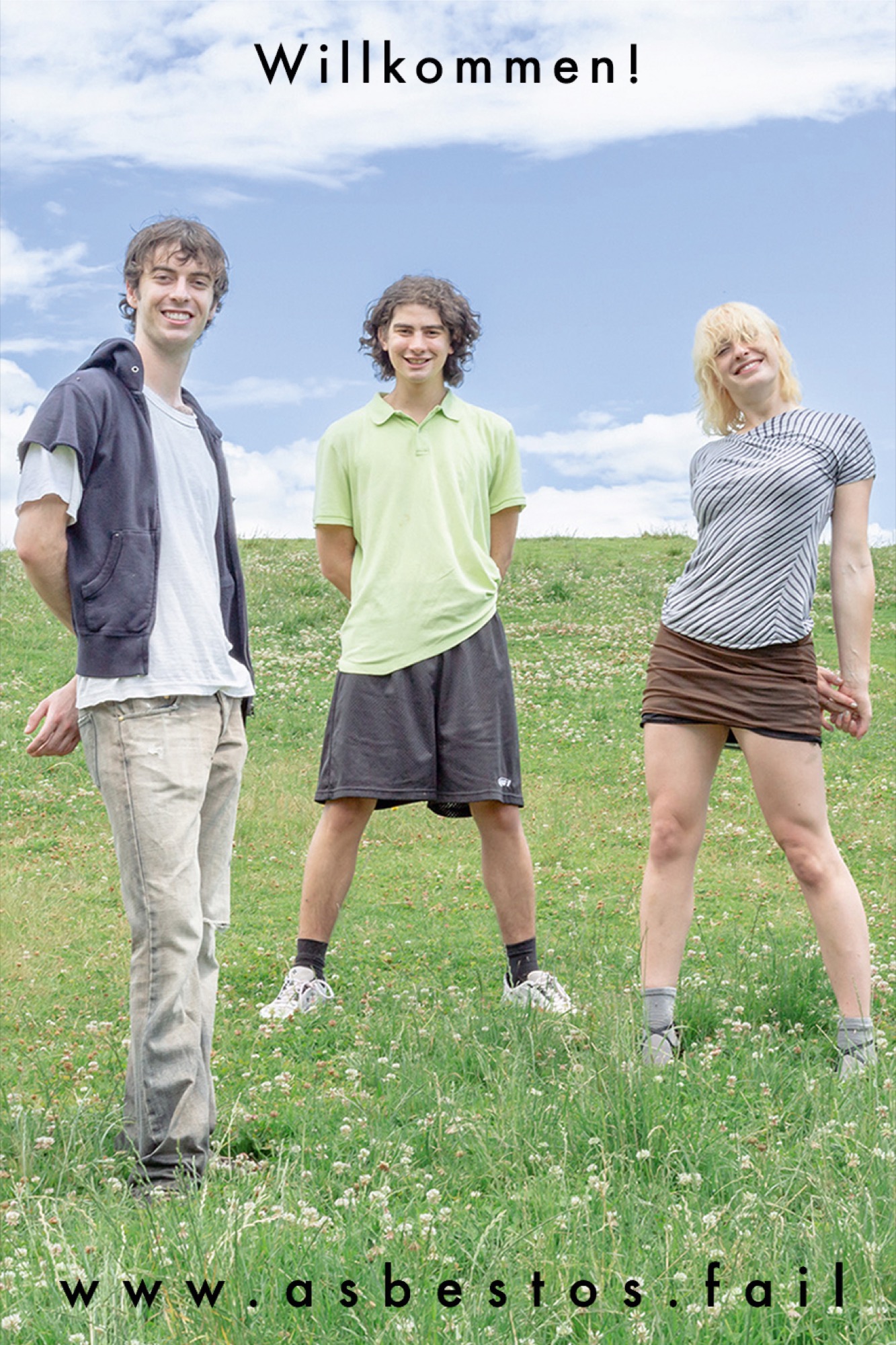
Audrey Schmidt is a writer and Melbourne Personality.


